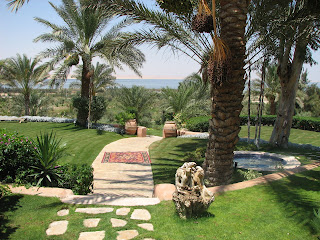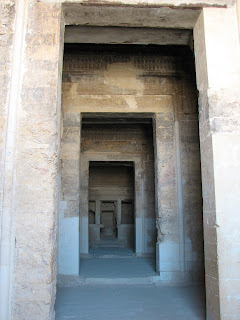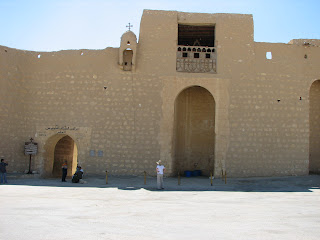First off, the taxi driver didn't know where the Bab Zuweila gate was and dropped us off at the Al Ghuri mosque instead which was fine once we figured out where we were. Al Ghuri was the last Mamluke sultan before the Turks took over in 1517. He was both known for his ruthlessness and his love of the arts and architecture. This mosque and madrassa (school) stands as a tribute to the architecture side :) By the way, we had forgotten to bring our nicer camera and the photos show it. These are shots of the prayer hall, still used today. The digital display you see (with the red numbers) indicate the prayer times for the day.


We went up to this minaret and had a look around.

This gives you an idea of what we saw. The mosque on the hill is the Muhammad Ali mosque which is part of the Citadel complex. The street below is Al Muizz street which we would soon be walking along.



A few minutes later, here is that same Al Muizz street close up. Each area of Al Muizz was known for selling something different: fruit, perfumes, gold, spices, etc. This area used to be the Silk Merchants bazaar and there is still some remnant of that today, if not silk at least textiles.
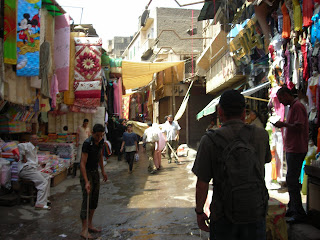
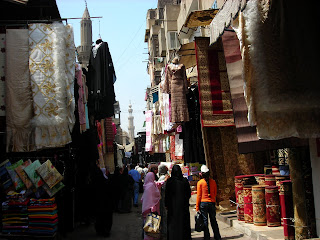
As we were walking along, a man came up behind David and said "Hey, you can walk like an Egyptian, because now you are in Egypt!" He was smiling and said "Welcome to Egypt! I hope you have a wonderful visit" We chatted for a bit and found out his name was Bebo and he was a professor at this Islamic design school just down the way. He was pointing out various lanes he takes his students through and telling us we have to go down there because there's a workshop where they dye silk and down here because there's a workshop where they blow glass and this way they have the best lamb kebabs and if he didn't have a class, he'd show us around. Finally, he looked at David's watch and said "Let's just go". So we followed him around as he pointed out various design features and explained the history of various buildings as well as showing us some workshops. He ended up calling his colleague and asking if he could teach his class.
Here is the workshop where they hand-dye the silk.


This used to be a harem. The mashrabiya woodwork on the second story allowed women to witness the activities on the street below without being seen.

Bebo showed us a very old printing press which still prints Korans for the famous Al Azhar mosque nearby. And then he took us to this workshop where they make mahogany boxes inlaid with very small pieces of camel bone, ebony, turquoise, and mother of pearl. This is the box and backgammon board we bought. I thought they were so beautiful!



Now I can't remember the building on the left! But the one on the right is the Al-Muayyad mosque, complete with sundial to keep track of the time for prayer. Can you see it??



There were several stands of these lamps. Bebo explained that these lamps were for Ramadan (coming up in August) and each night every family hangs it outside their house or apartment.

Finally we came to Bab Zuweila Gate, built around the 1090s. The photo on the right shows where public executions took place, both sultans and commoners have been hanged here.

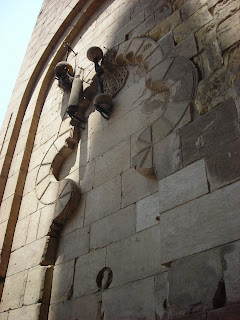

Bebo asked if we would join him for tea and took us to his regular stop. We've seen these tea shops everywhere with groups of men sitting around talking and smoking their sheeshas, or water pipes. We were honored to sit and chat with Bebo's friends (I tried out my Arabic but mostly Bebo translated :) By the way, he seemed to know everyone as we walked down Al Muizz street, greeting everyone and occasionally shaking hands or kissing their cheeks. Bebo got a sheesha for David to try out and insisted I try his so he could take a picture of us. I was surprised at the tobacco's mild taste...it wasn't that bad at all.
Oh and that brown beverage you see on that vendor's cart behind us is called Soos. Earlier that morning, Bebo insisted we try it. He called it "yellow tea" and said it was a great thirst quencher. A man was walking around with a tub of it on his back and Bebo bought us a glass of it to try. I told David that it tasted like dirt water and mint to me...but it was cold and I have to admit it was refreshing. Bebo downed his with great gusto. What interested us was the fact that our beverage guy only had 3 glasses...when one person finished, he quickly rinsed it out with water and handed it to the next guy!
 And here's Bebo. We're constantly amazed at the generosity we're met with here. He seemed to have no other incentive than to make sure we have a good experience here in Egypt and he told us to please call him up next time we'd like to see more of the Islamic quarter and he will "show us things we've never seen before". We can't wait. :)
And here's Bebo. We're constantly amazed at the generosity we're met with here. He seemed to have no other incentive than to make sure we have a good experience here in Egypt and he told us to please call him up next time we'd like to see more of the Islamic quarter and he will "show us things we've never seen before". We can't wait. :)



